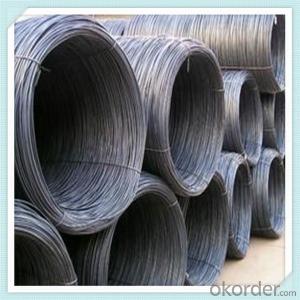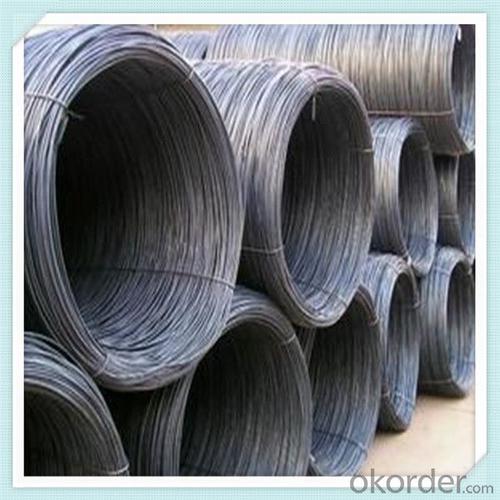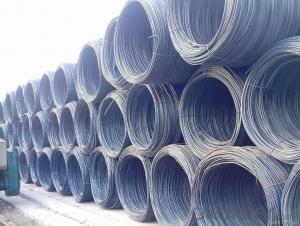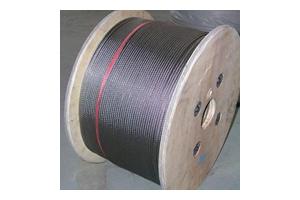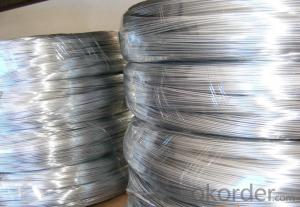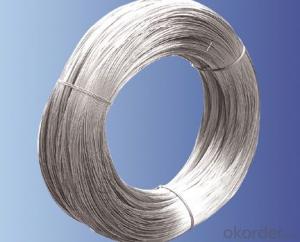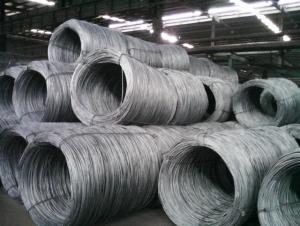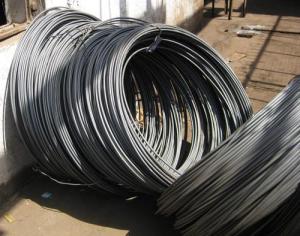Steel wire rod of good quality sale directly for mill
- Loading Port:
- Guangzhou
- Payment Terms:
- TT OR LC
- Min Order Qty:
- 100 m.t.
- Supply Capability:
- 11592 m.t./month
OKorder Service Pledge
OKorder Financial Service
You Might Also Like
Specification
Wire rod is used for many different products. Depending upon how it is cold formed and heat treated, wire
is used, for example, to produce not only wire ropes, barbed wire, wire mesh and nails, but also springs,
welded wire mesh and reinforcement wire.
Features
1、Pure steel quality, stable chemical contents, small tolerance.
2、Constant Quality, good drawing performance.
3、High dimension accuracy degree, accuracy degree of Level C up to 80%, smooth surface, less scale,
easy to be pickled.
4、Automatic bundling with 4 lines by Machine in tidy and good looks
5、Big high quality percentage, small coil percentage, and heavy coil weight for Hard Coil.
6、High sorbitizing percentage.
Product Description :
Standard | AISI, ASTM, BS, DIN, GB, JIS |
Material/steel grade | Q195-Q235,SAE1006B,SAE1006CR, SAE1008B, SAE1008CR, SAE1010B, SAE1018B, or according to customers requirements |
Wire Gauge | 5.5-12mm |
Coil weight | 1.8-2.1mts |
MOQ | 25MT |
Delivery Time | 15-30 days after receipt of L/C or deposit by T/T |
Packing | In coil and load in container, if large quantity, by bulk vessel; Can be packed as customers' special requirements |
Payment terms | 1).100% irrevocable L/C at sight. 2).30% T/T prepaid and the balance against the copy of B/L. 3).30% T/T prepaid and the balance against L/C |
Application | widely used in machinery parts, manufacturing industry, electronics industry, metal tools and others |
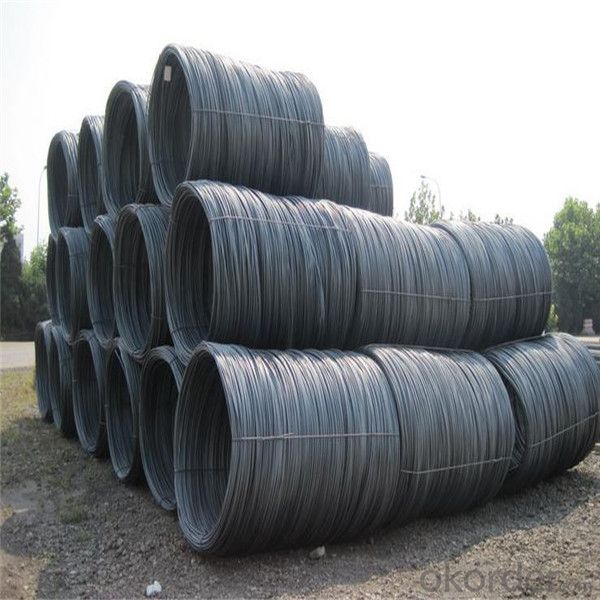
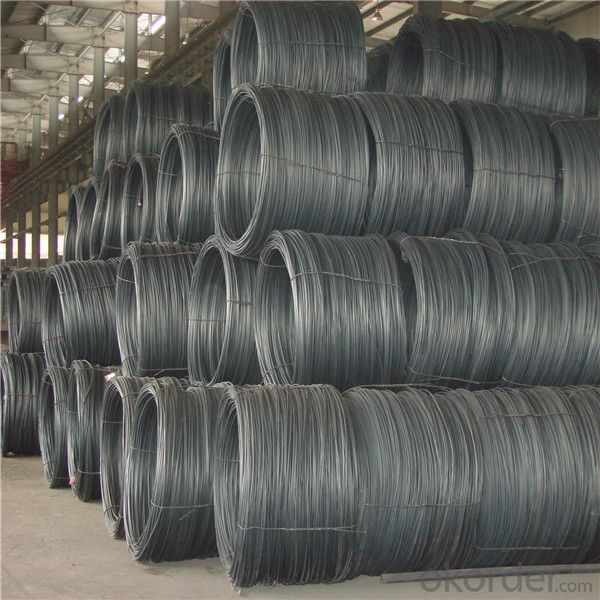
Application :
It generally used in braiding the hose for bathing product and machinery. With it
good flexibility, resistant to high temperature and resistant to corrosion, it
used widely in many industries.
Packing :
Hot-rolled wire rod is held in a unit with at least four steel straps in the
transverse direction and transported and stored without further packaging.
Before
the steel strapping is applied, the wire rod must be sufficiently compressed.
The strapping is fixed in the transverse direction with a single circumferential
strap so that the strapping does not slip and cause the coil to come apart.
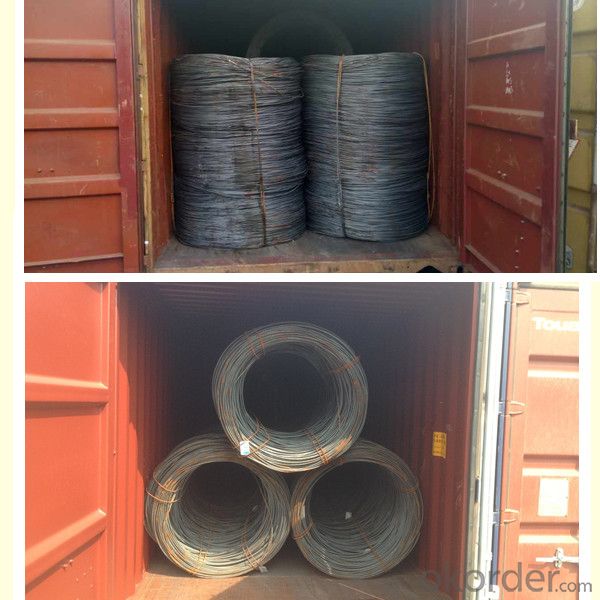
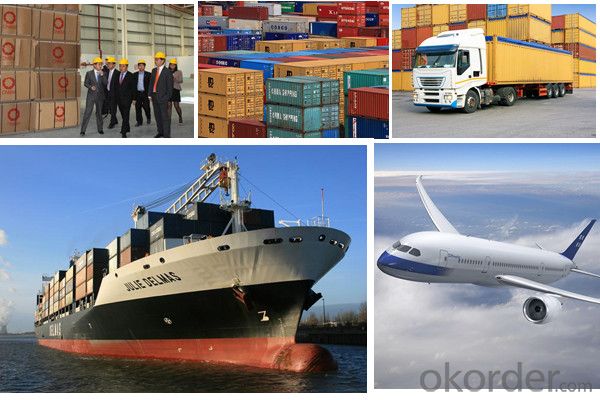
Our service:
(1) We cooperate with famous factories with advanced equipment and well trained workers.
(2) We can provide factory price with trading company service.
(3) We continuously work on the improvement of our processes, guaranteeing
consistently high standards of quality to keep none compensation.
(4) We guarantee 24 hours response and 48 hours solution providing service.
(5) We accept small order quantity before formal cooperation.
(6) We deliver the agreed quality at the agreed time, reacting to changes in
customer wishes in a flexible way.
(7) Due to our volume and selling power, we have excellent freight rates with
shipping lines.
(8) We strive to always be fair and honest in our dealings with customers.
(9) We strive to work together with customers to achieve much more than we can
achieve alone.
(10) Through our passion and commitment we aim to be a market leader in all our
key markets. To maintain our position as market leader we must continue to add
value in all that we do.
FAQ:
1.Q: What's your MOQ(minimum order quantity)?
A: One full container, mixed acceptable .
2. Q: What's your packing methods?
A: Packed in bundle or bulk ..
3. Q: How can I buy CNBM products in my country?
A:Please send us an inquiry or email ,we will reply to you if there is distributor in your country
4. Q: Can we visit your factory?
A: Warmly welcome. Once we have your schedule, we will arrange the
professional sales team to follow up your case.
5. Q: How long does it take to get the product if i place an order?
A:With the process of your requirements,we will pack and deliver in 3
-7 days. If it is by sea shipment,it will take 15-45 days depending on different locations
- Q: What are the main factors influencing the choice of steel wire rod order warranty claims process?
- The main factors influencing the choice of steel wire rod order warranty claims process can vary depending on various aspects. Firstly, the quality of the steel wire rod plays a significant role in determining the warranty claims process. If the wire rod is of high quality and meets the required standards, then the warranty claims process may be less frequent and straightforward. On the other hand, if the wire rod has inherent flaws or defects, it is more likely to result in warranty claims, and the process may be more complex. Secondly, the terms and conditions of the warranty provided by the supplier or manufacturer can greatly influence the choice of the warranty claims process. The duration of the warranty, the coverage provided, and any limitations or exclusions can impact the decision-making process. If the warranty offers comprehensive coverage and is backed by a reputable supplier, it may instill confidence in the buyer, making them more inclined to choose that particular warranty claims process. Furthermore, the availability and efficiency of customer support and after-sales service are important factors in deciding the warranty claims process. A prompt and responsive customer support team can expedite the claims process, provide necessary guidance, and address any concerns or queries from the buyer. This level of support can significantly influence the choice of the warranty claims process, as it ensures a smoother and more satisfactory experience for the buyer. Additionally, the reputation and track record of the supplier or manufacturer can also impact the decision-making process. Buyers are more likely to choose a warranty claims process from a trusted and reliable supplier with a history of honoring their warranty obligations promptly and fairly. This factor can provide peace of mind to the buyer and increase their confidence in choosing a particular warranty claims process. Lastly, the cost and convenience of the warranty claims process can also influence the choice. If the process is cost-effective and convenient for the buyer, they may be more inclined to choose that particular warranty claims process. This can include factors such as the ease of filing a claim, the time taken for resolution, and any associated costs or deductibles. Overall, the main factors influencing the choice of steel wire rod order warranty claims process revolve around the quality of the product, the terms and conditions of the warranty, the availability of customer support, the reputation of the supplier, and the cost and convenience of the process.
- Q: How is steel wire rod used in the manufacturing of paper clips?
- Steel wire rod is used in the manufacturing of paper clips as it provides the necessary strength and flexibility required to form the clip shape. The rod is first cut into small lengths and then bent into the classic paper clip design using specialized machinery. This process ensures that the paper clips are durable and can securely hold papers together.
- Q: How is steel wire rod used in the manufacturing of wire for telecommunications cables?
- Wire rod made of steel is an indispensable element in the production of wire for telecommunications cables. The process starts with the creation of steel wire rod, which is a long, cylindrical billet composed of steel. This wire rod is then treated and converted into a wire that is appropriate for telecommunications cables. To manufacture wire for telecommunications cables, various steps are taken with the steel wire rod. Initially, it is purified and descaled to eliminate any impurities that could impact the wire's quality. Subsequently, the wire rod is heated and passed through a series of rollers to decrease its diameter and increase its length. This stage, known as wire drawing, is crucial in achieving the desired thickness and strength of the wire. Once the wire has been drawn to the necessary size, it undergoes further processing to ensure its quality and dependability. The wire is annealed, a process in which it is heated and slowly cooled to relieve internal stresses and improve its flexibility. This makes the wire more suitable for handling and installation in telecommunications cables. Following annealing, the wire is coated with a layer of insulation material, such as polyethylene or polyvinyl chloride (PVC). This insulation provides electrical insulation and safeguards the wire from external factors that could harm its conductivity, such as moisture or extreme temperatures. The final step in the manufacturing process involves twisting multiple wires together to form a cable. Steel wire rod serves as the core strength member within the cable, delivering structural support and tensile strength. This ensures the cable can endure the tension and bending forces it may encounter during installation and operation. In conclusion, steel wire rod plays a crucial role in the production of wire for telecommunications cables. It goes through several processes, including purification, wire drawing, annealing, and insulation, to create a wire suitable for telecommunications applications. The strength and reliability of steel wire rod make it an ideal choice for providing the necessary structural support and durability required in telecommunications cables.
- Q: What are the common production processes for nickel-coated steel wire rod?
- The common production processes for nickel-coated steel wire rod include cleaning and pickling the steel rod, pre-coating it with a layer of copper to enhance adhesion, passing it through a nickel plating bath to deposit a layer of nickel, and finally, subjecting it to heat treatment to improve the coating's properties.
- Q: How is steel wire rod classified based on its carbon content?
- Steel wire rod can be classified based on its carbon content into three main categories: low carbon wire rod, medium carbon wire rod, and high carbon wire rod. Low carbon wire rod typically contains carbon levels ranging from 0.05% to 0.15%. It is characterized by its high ductility and excellent formability. This type of wire rod is commonly used in applications that require flexibility and bending, such as in the manufacturing of wires for fencing, nails, and construction materials. Medium carbon wire rod contains carbon levels ranging from 0.15% to 0.45%. It possesses higher strength and hardness compared to low carbon wire rod. Medium carbon wire rod is often used in applications that require both strength and flexibility, such as in the production of automotive parts, springs, and certain types of fasteners. High carbon wire rod has carbon levels ranging from 0.45% to 0.85%. It is known for its exceptional strength and hardness. High carbon wire rod is typically used in applications that require maximum strength, such as in the production of high-tensile wires used for suspension bridges, pre-stressed concrete structures, and wire ropes used in heavy machinery. The classification of steel wire rod based on carbon content allows manufacturers and consumers to choose the appropriate grade of wire rod for their specific needs, considering factors such as strength, flexibility, and durability requirements.
- Q: How is the weldability of steel wire rod evaluated?
- The weldability of steel wire rod is typically evaluated through various tests and assessments such as bend tests, tensile tests, and Charpy impact tests. These tests help determine the weldability characteristics of the steel wire rod, including its ability to withstand welding processes without developing defects or cracks. Additionally, the chemical composition, microstructure, and mechanical properties of the steel wire rod are also considered in evaluating its weldability.
- Q: What are the different types of steel wire rod coatings used for increased strength?
- The different types of steel wire rod coatings used for increased strength include galvanized coatings, zinc-aluminum coatings, and epoxy coatings.
- Q: How is steel wire rod used in the manufacturing of wire rope pulleys?
- Steel wire rod is used in the manufacturing of wire rope pulleys as the primary material for constructing the pulley's core or center. The steel wire rod is typically shaped into a circular form and then wound tightly to create the pulley's core. This core provides strength and stability to the wire rope pulley, allowing it to effectively support and guide the wire rope during operation.
- Q: How does the brittleness of steel wire rod vary with different wire drawing processes?
- The brittleness of steel wire rod can vary with different wire drawing processes. Wire drawing is a metalworking process used to reduce the diameter of a wire by pulling it through a series of dies. The specific wire drawing process used can have a significant impact on the final properties of the wire, including its brittleness. One factor that affects the brittleness of steel wire rod is the reduction in area during the wire drawing process. The reduction in area refers to the amount of material that is removed from the wire as it is drawn through the dies. Higher reductions in area result in a greater degree of deformation and strain on the wire, which can lead to increased brittleness. This is because the grain structure of the steel becomes more elongated and aligned, making it more susceptible to cracking and breaking under stress. Another factor that influences the brittleness of steel wire rod is the speed at which the wire is drawn. Higher drawing speeds can create higher levels of strain and deformation in the wire, which can increase its brittleness. Rapid cooling of the wire during the drawing process can also contribute to brittleness, as it can lead to the formation of brittle phases in the steel microstructure. Furthermore, the heat treatment applied to the wire after the drawing process can also impact its brittleness. Heat treatment processes, such as annealing, can help to relieve internal stresses and improve the ductility of the wire, thereby reducing its brittleness. On the other hand, improper heat treatment or inadequate cooling can result in increased brittleness. In summary, the brittleness of steel wire rod can vary with different wire drawing processes. Factors such as the reduction in area, drawing speed, cooling rate, and heat treatment all play a role in determining the final brittleness of the wire. It is essential for manufacturers to carefully control these parameters to achieve the desired mechanical properties in the wire.
- Q: How are steel wire rods used in the manufacturing of screws and bolts?
- Steel wire rods are an integral component in the manufacturing of screws and bolts. These wire rods serve as the raw material from which the screws and bolts are formed. The manufacturing process begins with the selection of high-quality steel wire rods that possess the desired strength and durability characteristics needed for screws and bolts. These wire rods are then subjected to various processes such as heating, rolling, and drawing to transform them into thinner wire forms with precise dimensions. The drawn wire is then further processed through a series of steps to create the specific shape and thread pattern required for screws and bolts. For instance, the wire may be cut into shorter lengths, and the ends are typically chamfered or beveled to allow for easier insertion into materials. Once the wire has been shaped and prepared, it undergoes a threading process. This involves the creation of helical ridges on the wire, which will later enable the screw or bolt to securely fasten objects together. The threading can be done using different methods, such as rolling, cutting, or grinding, depending on the desired type of screw or bolt. After the threading process, the wire is cut into individual pieces of the desired length, and the heads of screws or bolts are formed using various techniques like cold forging or hot forging. Cold forging involves shaping the head by applying pressure to the cold wire, while hot forging involves heating the wire before shaping it. Following the formation of the heads, the screws and bolts are subjected to additional processes such as heat treatment, surface coating, and quality control inspections. These processes ensure that the final product meets the required strength, corrosion resistance, and dimensional accuracy standards. In summary, steel wire rods play a crucial role in the manufacturing of screws and bolts. They serve as the starting material and undergo various processes, including shaping, threading, and forming, to ultimately produce the high-quality screws and bolts that are widely used in numerous industries.
Send your message to us
Steel wire rod of good quality sale directly for mill
- Loading Port:
- Guangzhou
- Payment Terms:
- TT OR LC
- Min Order Qty:
- 100 m.t.
- Supply Capability:
- 11592 m.t./month
OKorder Service Pledge
OKorder Financial Service
Similar products
Hot products
Hot Searches
Related keywords
